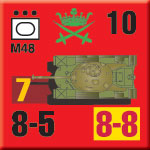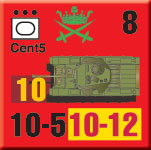1967 Sword of Israel:
The Royal Jordanian Army, Part One
by Mike Bennighof, Ph.D.
March 2024
 For years before the 1967 war, the Hashemite Kingdom of Jordan stood opposed to the radical Arab nationalist regimes ruling Egypt and Syria. The Jordanians backed the royalist side in the Yemeni civil war that raged throughout the 1960’s, even as 50,000 Egyptian troops backed the republican faction. Syria in particular vilified King Hussein in its propaganda, accusing him of betraying the Arab cause. For years before the 1967 war, the Hashemite Kingdom of Jordan stood opposed to the radical Arab nationalist regimes ruling Egypt and Syria. The Jordanians backed the royalist side in the Yemeni civil war that raged throughout the 1960’s, even as 50,000 Egyptian troops backed the republican faction. Syria in particular vilified King Hussein in its propaganda, accusing him of betraying the Arab cause.
Hussein wished to maintain ties with the United States, even after the creation of the Unified Arab Command in 1964 to coordinate military efforts among the Arab states. Egypt, Syria, Iraq and Saudi Arabia all pressured Jordan to expand its military and accept troops from other Arab states on its soil during peacetime.
A poor country, Jordan could not afford the military upgrades demanded by her putative allies, but they backed their insistence with cash – the other Arab states, the Saudis in particular, would foot the bill. Iraq, Egypt and Syria pressed the Jordanians to acquire tanks and aircraft from the Soviet Union to assure compatibility with those of their own forces. Hussein resisted, not wishing to be drawn into the Soviet orbit or accept Soviet advisors on his territory. And so he turned to the United States, Jordan’s tacit sponsor since 1957 though the two nations did not have a formal treaty relationship.
The Johnson Administration wanted to keep Soviet influence from spreading to another Middle Eastern state, even one as small and oil-deprived as Jordan. And both the president and a number of his advisors smarted over the Eshkol government’s failure to keep secret the American sale of M48 tanks to Israel. Seeking to soothe angry Arab states and deliver a symbolic reprimand to the Israelis, Johnson agreed to a package of sales to Jordan including M48 tanks, M113 armored personnel carriers and F104 supersonic fighter planes.
Here’s a look at Jordan’s arsenal, as seen in our Panzer Grenadier (Modern): 1967 Sword of Israel:
Armor: The Patton Tank
 Jordan fielded two tank brigades in 1967, each with two tank battalions of new M48 Patton tanks and one of mechanized infantry. The Jordanian M48 and M48A1 Patton tanks arrived in their original state, with the 90mm M41 main gun. The two models differed only slightly; the M48A1 had a larger commander’s cupola that allowed the turret-mounted .50-caliber machine gun to be loaded and fired from within the tank, and a larger driver’s hatch. In game terms, that’s not enough to rate two different playing pieces and the Jordanians seem to have issued them without regard to model. Jordan fielded two tank brigades in 1967, each with two tank battalions of new M48 Patton tanks and one of mechanized infantry. The Jordanian M48 and M48A1 Patton tanks arrived in their original state, with the 90mm M41 main gun. The two models differed only slightly; the M48A1 had a larger commander’s cupola that allowed the turret-mounted .50-caliber machine gun to be loaded and fired from within the tank, and a larger driver’s hatch. In game terms, that’s not enough to rate two different playing pieces and the Jordanians seem to have issued them without regard to model.
Israeli M48 tanks deployed during the Six Day War had been upgraded with the awesome British-designed L7 105mm gun, usually the American-made M68 licensed version supplied in an “upgrade kit.” The Israelis had failed to maintain the secrecy demanded by the Americans regarding the upgrade, and when the Jordanians asked for “a similar tank” they apparently believed that they would receive the upgrade as well.
Jordan purchased 200 of the tanks, using Arab-supplied funds; 170 of these were available for action on 5 June 1967. The elite 40th Armored Brigade, a Bedouin outfit, had two battalions of M48 Pattons while the 60th Armored Brigade had two on paper only one of them seems to have seen major action, with the other suffering serious losses to Israeli air strikes before it could come to grips with the enemy.
Of the 170 M48 Patton tanks present on the West Bank on the afternoon of 5 June 1967, one made it back to the East Bank. The Israelis took approximately 100 of them into their own service, those captured intact or in repairable condition.
Armor: The Centurion Tank
 Using their Arab grant, the Royal Jordanian Army also purchased fifty Centurion 5 tanks from Great Britain, joining fifty machines previously acquired in the 1950’s. The Jordanians fielded 44 of the machines in the 10th Independent Tank Battalion, stationed near Hebron in the southern part of the West Bank. Another 45 Centurions equipped the tank regiment of the Royal Guard Brigade, which remained at Amman on the East Bank throughout the conflict. Using their Arab grant, the Royal Jordanian Army also purchased fifty Centurion 5 tanks from Great Britain, joining fifty machines previously acquired in the 1950’s. The Jordanians fielded 44 of the machines in the 10th Independent Tank Battalion, stationed near Hebron in the southern part of the West Bank. Another 45 Centurions equipped the tank regiment of the Royal Guard Brigade, which remained at Amman on the East Bank throughout the conflict.
The British Army’s first Centurions went to the front lines in Belgium at the very end of World War II but arrived too late to engage any Germans. Two decades later the tank remained a potent weapon, particularly in a defensive role. The tank performed well in Korea and Britain exported it widely in the decade that followed; Israel and Egypt also operated Centurions. Both Israel and Jordan still use some Centurions modified as armored personnel carriers.
Jordanian Centurions did not carry the Royal Ordnance L7 105mm rifled cannon that armed Israeli machines; they still had the effective but less awesome Royal Ordnance QF 20-pounder (84mm). This gun had automatic stabilization and was considered a better weapon than the American 90mm gun carried by the M48 Patton. After the Six Day War the Jordanians upgraded their surviving Centurions to carry the L7 105mm.
Excruciatingly slow and drinking enormous amounts of fuel, the Centurion offered outstanding protection. Its short range was seen as a major disadvantage, limiting it to the infantry support role in 1967; the Jordanians would change their minds afterwards and re-equipped their elite 40th Armored Brigade with Centurions.
Despite the Centurion’s good features, the Royal Jordanian Army assigned its best crews and officers to the two tank brigades, leaving its two independent battalions with second-rate personnel and this decision had dire consequences in the Six Day War. The 10th Tank Battalion fell apart when the Jordanian high command ordered a general retreat, and abandoned its Centurions. The Israelis took over 30 of them in an undamaged state and incorporated them into their own forces after upgrading them with the bigger gun and new engines.
Jordan’s 12th Independent Tank Battalion had 49 American-made M47 Patton tanks declared obsolete by the Americans in 1957 and sold to Jordan. Tasked with supporting the 25th “Khalid ibn al-Walid” Infantry Brigade at Janin on the very northern edge of the West Bank, the 12th Tank Battalion failed to conduct an ordered attack on the afternoon of 5 June, but fought well when attacked by Israeli tanks and infantry. However, the Jordanian tankers rushed out of their dug-in positions to pursue the retreating Israelis and were shot to pieces by the better-led and better-trained Israeli armor.
After the war ended, the Saudis and the Arab Gulf States provided a $100 million grant to Jordan, which replaced all of its M48 Patton and Centurion tank losses; the M47 tanks were replaced by new M48 vehicles.
You can order 1967: Sword of Israel (Playbook edition) right here.
Arab-Israeli Package
1967: Sword of Israel (Playbook)
IDF: Israel Defense Forces
Voice of the Arabs
Retail Price: $147.97
Package Price: $120
Gold Club Price: $96
You can experience the Arab-Israeli Package right here.
Sign up for our newsletter right here. Your info will never be sold or transferred; we'll just use it to update you on new games and new offers.
Mike Bennighof is president of Avalanche Press and holds a doctorate in history from Emory University. A Fulbright Scholar and NASA Journalist in Space finalist, he has published a great many books, games and articles on historical subjects; people are saying that some of them are actually good.
He lives in Birmingham, Alabama with his wife, three children, and his new puppy. He misses his Iron Dog, Leopold.
Want to keep Daily Content free of third-party ads? You can send us some love (and cash) through this link right here.
|
